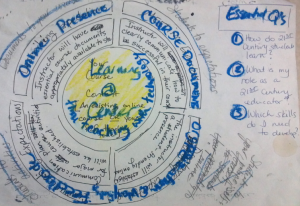Ever wish things could remain the same and the world would stop changing? The effect of time on our bodies is something that gets a lot of publicity with numerous strategies to keep us looking as young as ever without grey hair, wrinkles, or weight shifts. Yet, it takes a lot more time and effort than when we were young to keep up appearances.
The passing of time does similar things to the curriculum we teach, shifting to adapt to developing technologies and a changing society. A constant bombardment of new technologies and programs to add to existing workloads promises to meet the needs of our 21st Century learners. Over time, these shifts can wreak havoc with our  course content and our workload. As one faculty member said in a teachingSOLUTIONS workshop,
course content and our workload. As one faculty member said in a teachingSOLUTIONS workshop,
“So far, 400 pounds in a bikini. Definitely a mix of outcomes and activities (in the course). Definitely not user friendly yet, whether the students were in school in the 50s or the 21st Century.”
Would you want to sign up for a class promising to look like that? Fortunately, there is a simple fix for this common curriculum problem of course drift and shift that will save us time and energy. It centers around asking yourself one of the five timeless questions of teaching and learning: “What knowledge is of most worth? (Curriculum)” Deciding upon these enduring concepts and understandings provides us with the gold standard for writing our course or program learning outcomes.
Much like our essence as a person does not change when we age, every course has fundamental concepts and ideas that are immune to the fickle winds of change and/or the latest and greatest technology tools/teaching strategies. This alignment grid from faculty eCommons is one tool to help us select what will fit perfectly in our 1-5 credit course.
Not sure your outcomes reflect the goals of the course, program, and NMC? Want someone to act as a sounding board to help you put your current goals into student-friendly language on both the course outline form and your syllabus? As an instructional designer, I am happy to help you wordsmith your outcomes and make sure your alignment works for you. Please give me a call (231-995-1957) or email me at trusso@nmc.edu and we can find a time that can work for you or a small group to plan together and keep our body of curriculum looking and feeling good!
If you would like a humorous view of misalignment from the students’ perspective, take a few minutes to watch: “Professor Dancelot and the Perils of a Misaligned Course.” After all, the students are the ultimate reason why we are engaging in these pedagogical discussions about aligning our outcomes.
Additional Resources:
- The 2014 Revised NMC Course Outline form and directions are located on the Forms page.
- An NMC course planning matrix for the Signmificant Learning Outcomes of a 15 week course. Permission granted to make copies and adjust as needed.
- Available face-to-face workshops to support writing Significant Learning Outcomes
- Dee Fink’s guide to writing Significant Learning Outcomes (This link goes to his course design guide; the worksheet on learning outcomes begins on page 11).


